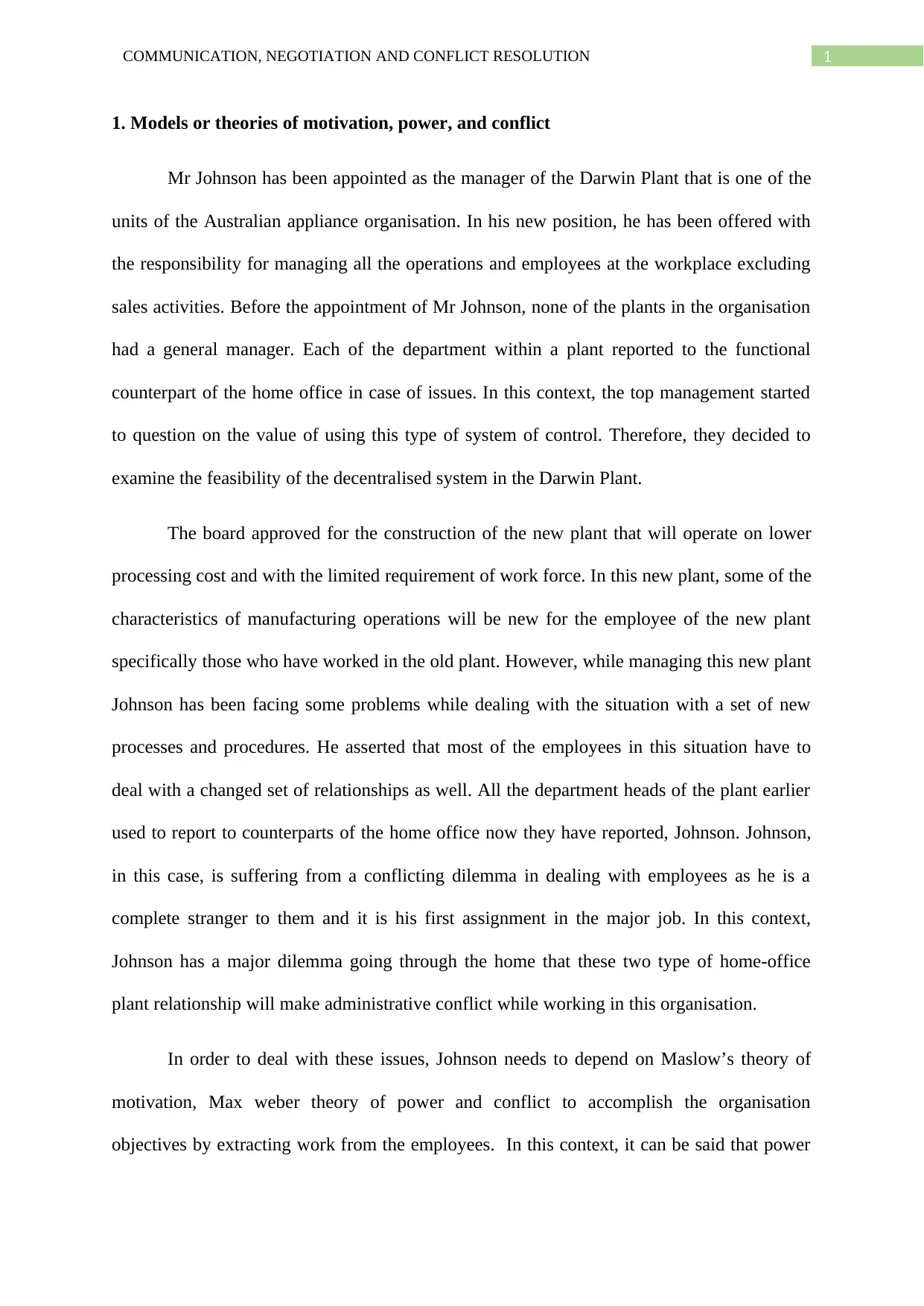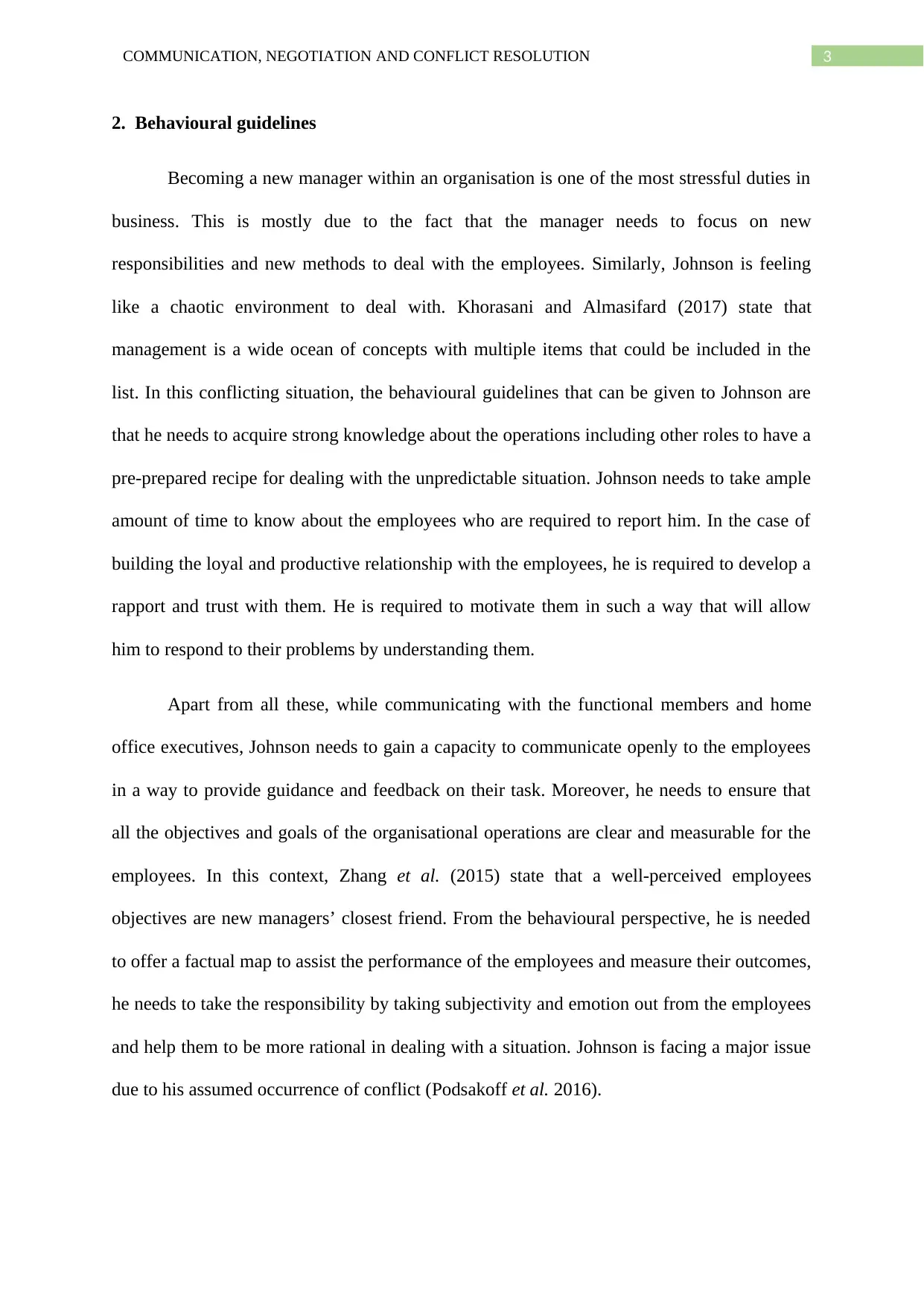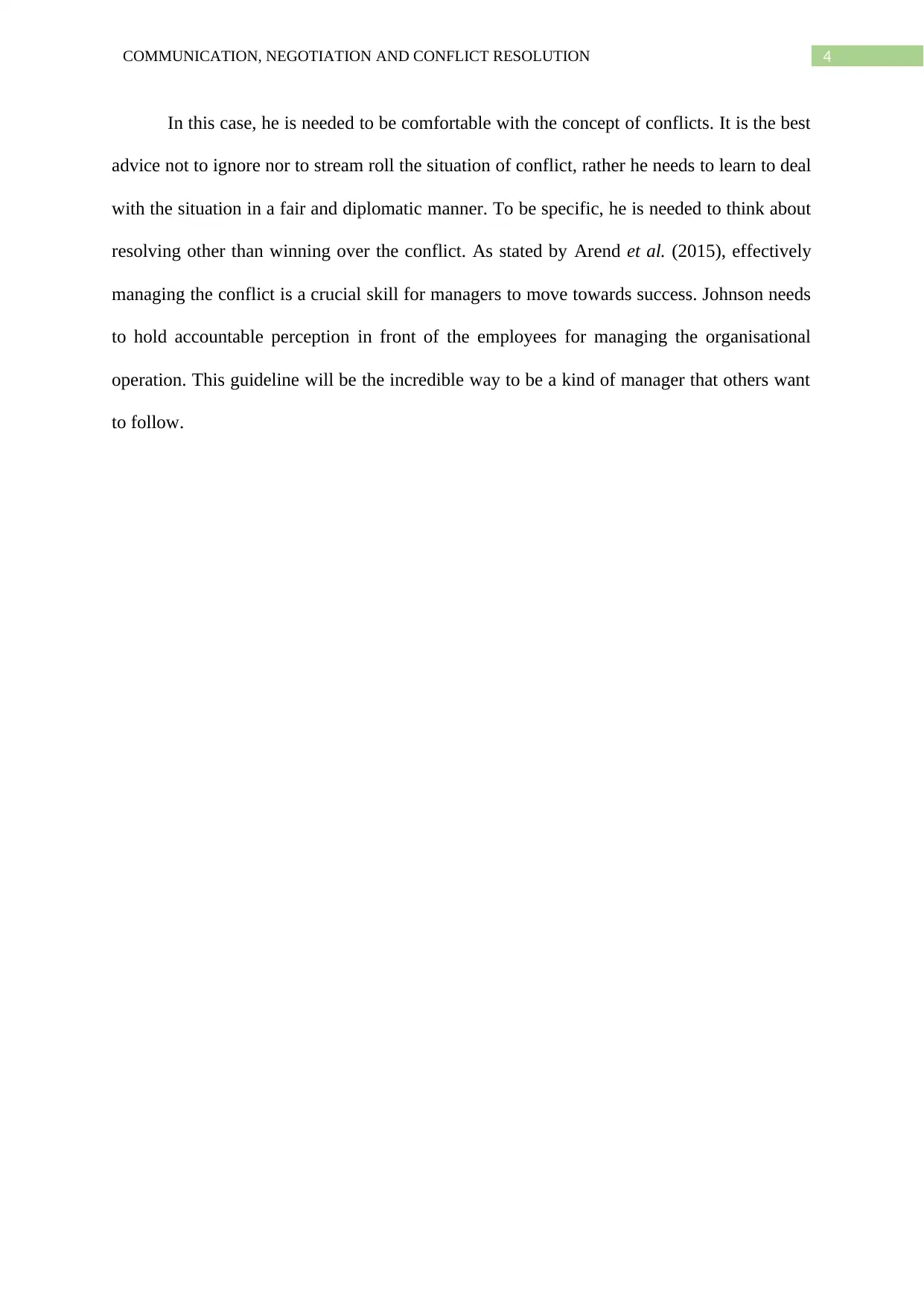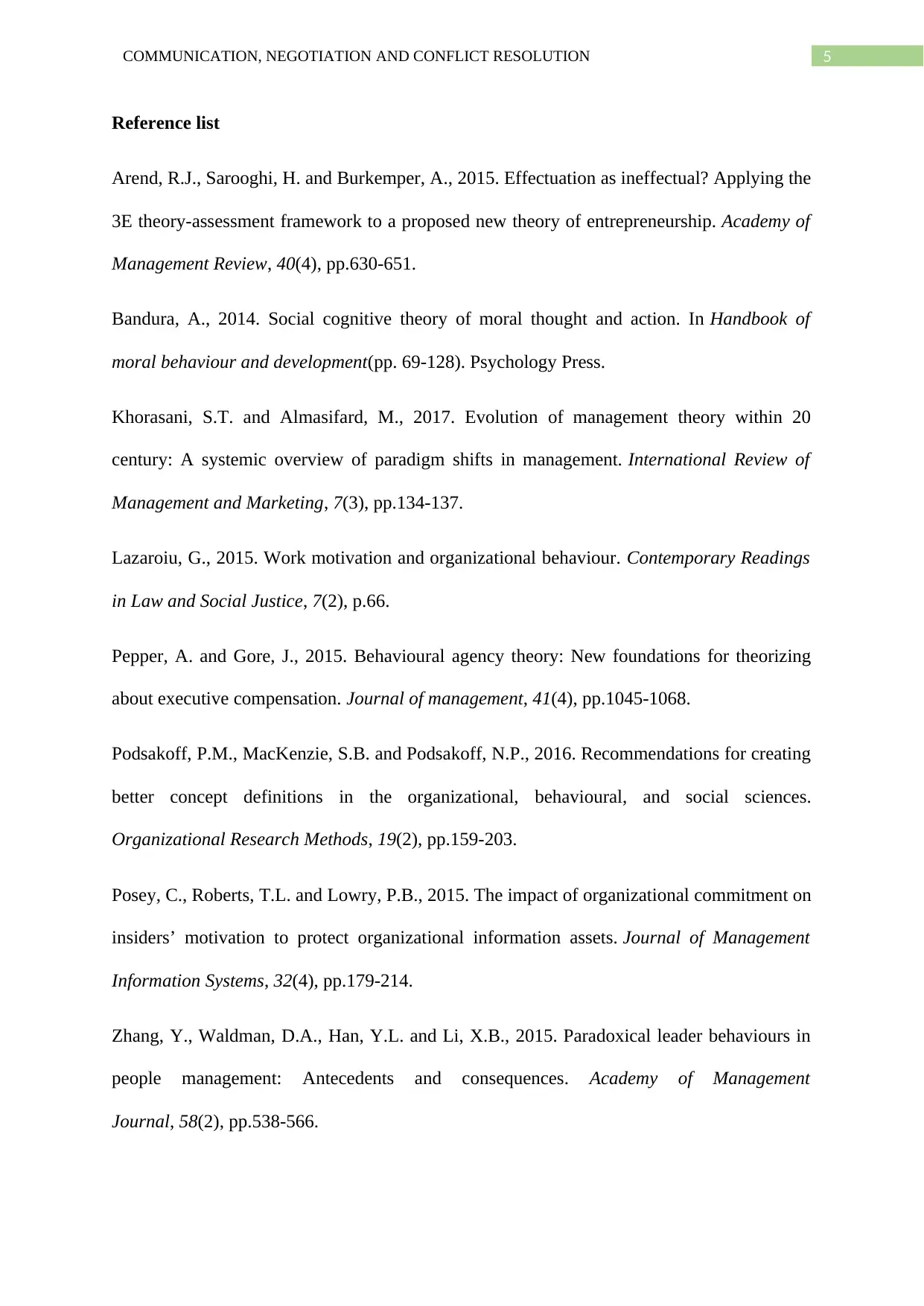Communication, Negotiation, and Conflict Resolution Report - Analysis
VerifiedAdded on 2023/06/07
|6
|1614
|253
Report
AI Summary
This report analyzes a case study involving Mr. Johnson, the new manager of the Darwin Plant, who faces conflicts arising from a decentralized management system and new operational processes. The report explores the application of Maslow's theory of motivation and Max Weber's theory of power to address these conflicts. It examines behavioral guidelines for Mr. Johnson, emphasizing the importance of understanding employee needs, open communication, and fair conflict management. The analysis highlights the significance of building trust, motivating employees, and creating a rational approach to resolving workplace conflicts. The report draws on various academic sources to support its recommendations and provides a framework for effective leadership in managing conflict situations. The report concludes by emphasizing the importance of accountability and a diplomatic approach to conflict resolution for achieving organizational objectives.

Running Head: COMMUNICATION, NEGOTIATION AND CONFLICT RESOLUTION
COMMUNICATION, NEGOTIATION AND CONFLICT
RESOLUTION
Student ID
Name of the University
Authors Note
COMMUNICATION, NEGOTIATION AND CONFLICT
RESOLUTION
Student ID
Name of the University
Authors Note
Paraphrase This Document
Need a fresh take? Get an instant paraphrase of this document with our AI Paraphraser

1COMMUNICATION, NEGOTIATION AND CONFLICT RESOLUTION
1. Models or theories of motivation, power, and conflict
Mr Johnson has been appointed as the manager of the Darwin Plant that is one of the
units of the Australian appliance organisation. In his new position, he has been offered with
the responsibility for managing all the operations and employees at the workplace excluding
sales activities. Before the appointment of Mr Johnson, none of the plants in the organisation
had a general manager. Each of the department within a plant reported to the functional
counterpart of the home office in case of issues. In this context, the top management started
to question on the value of using this type of system of control. Therefore, they decided to
examine the feasibility of the decentralised system in the Darwin Plant.
The board approved for the construction of the new plant that will operate on lower
processing cost and with the limited requirement of work force. In this new plant, some of the
characteristics of manufacturing operations will be new for the employee of the new plant
specifically those who have worked in the old plant. However, while managing this new plant
Johnson has been facing some problems while dealing with the situation with a set of new
processes and procedures. He asserted that most of the employees in this situation have to
deal with a changed set of relationships as well. All the department heads of the plant earlier
used to report to counterparts of the home office now they have reported, Johnson. Johnson,
in this case, is suffering from a conflicting dilemma in dealing with employees as he is a
complete stranger to them and it is his first assignment in the major job. In this context,
Johnson has a major dilemma going through the home that these two type of home-office
plant relationship will make administrative conflict while working in this organisation.
In order to deal with these issues, Johnson needs to depend on Maslow’s theory of
motivation, Max weber theory of power and conflict to accomplish the organisation
objectives by extracting work from the employees. In this context, it can be said that power
1. Models or theories of motivation, power, and conflict
Mr Johnson has been appointed as the manager of the Darwin Plant that is one of the
units of the Australian appliance organisation. In his new position, he has been offered with
the responsibility for managing all the operations and employees at the workplace excluding
sales activities. Before the appointment of Mr Johnson, none of the plants in the organisation
had a general manager. Each of the department within a plant reported to the functional
counterpart of the home office in case of issues. In this context, the top management started
to question on the value of using this type of system of control. Therefore, they decided to
examine the feasibility of the decentralised system in the Darwin Plant.
The board approved for the construction of the new plant that will operate on lower
processing cost and with the limited requirement of work force. In this new plant, some of the
characteristics of manufacturing operations will be new for the employee of the new plant
specifically those who have worked in the old plant. However, while managing this new plant
Johnson has been facing some problems while dealing with the situation with a set of new
processes and procedures. He asserted that most of the employees in this situation have to
deal with a changed set of relationships as well. All the department heads of the plant earlier
used to report to counterparts of the home office now they have reported, Johnson. Johnson,
in this case, is suffering from a conflicting dilemma in dealing with employees as he is a
complete stranger to them and it is his first assignment in the major job. In this context,
Johnson has a major dilemma going through the home that these two type of home-office
plant relationship will make administrative conflict while working in this organisation.
In order to deal with these issues, Johnson needs to depend on Maslow’s theory of
motivation, Max weber theory of power and conflict to accomplish the organisation
objectives by extracting work from the employees. In this context, it can be said that power

2COMMUNICATION, NEGOTIATION AND CONFLICT RESOLUTION
is one of the most important determinants in enhancing the effectiveness of the manager.
Lazaroiu (2015) stated that power theory is the basic energy that is required to initiate and
sustain a critical situation. This will provide Johnson with the capability to transform
intentions into reality while dealing with multiple situations. According to Posey et al.
(2015), managers of power seeker needs to provide the working employees with an
opportunity to control all situation. However, Johnson is not a power seeker, as he does not
have any desire to control others or lead them to behave in the way he wants. According to
the Max Weber theory it has been claimed that organisational conflict occurs when an
individual is in need of more power than the following individual (Bandura 2014). In this
context, power influences relatively more than personally developed relationships; it helps to
shape wider dynamics such as social group and professional organisations.
This type of situation is more evident when the individuals within the organisation do
not know each other and are not compatible with each other. Individuals in this case often
fail to note down others perceptive and tend to disrespect other feelings. In order to avoid
these conflicts of power within the workplace Johnson is required to motivate the employees
by sharing ideas and opinions with them in case of the problem. According to the Maslow’s
theory of motivation, it is the foremost requirement of the employees to reduce the physical
pain and expanding pleasure (Pepper and Gore 2015). In this theory, Maslow describes that it
is necessary to meet the needs of the employees for understanding their problem. In addition
to this, Johnson is required to address psychological requirements, safety needs, and social
needs of the employees before approaching them personally. The theoretical perspective
includes the need of self-esteem and self-actualisation that will allow the employees towards
the achievement of confidence. Therefore, Johnson can motivate the employees by consulting
with them about the needful changes and tasks of the organisation by motivating them to
work together.
is one of the most important determinants in enhancing the effectiveness of the manager.
Lazaroiu (2015) stated that power theory is the basic energy that is required to initiate and
sustain a critical situation. This will provide Johnson with the capability to transform
intentions into reality while dealing with multiple situations. According to Posey et al.
(2015), managers of power seeker needs to provide the working employees with an
opportunity to control all situation. However, Johnson is not a power seeker, as he does not
have any desire to control others or lead them to behave in the way he wants. According to
the Max Weber theory it has been claimed that organisational conflict occurs when an
individual is in need of more power than the following individual (Bandura 2014). In this
context, power influences relatively more than personally developed relationships; it helps to
shape wider dynamics such as social group and professional organisations.
This type of situation is more evident when the individuals within the organisation do
not know each other and are not compatible with each other. Individuals in this case often
fail to note down others perceptive and tend to disrespect other feelings. In order to avoid
these conflicts of power within the workplace Johnson is required to motivate the employees
by sharing ideas and opinions with them in case of the problem. According to the Maslow’s
theory of motivation, it is the foremost requirement of the employees to reduce the physical
pain and expanding pleasure (Pepper and Gore 2015). In this theory, Maslow describes that it
is necessary to meet the needs of the employees for understanding their problem. In addition
to this, Johnson is required to address psychological requirements, safety needs, and social
needs of the employees before approaching them personally. The theoretical perspective
includes the need of self-esteem and self-actualisation that will allow the employees towards
the achievement of confidence. Therefore, Johnson can motivate the employees by consulting
with them about the needful changes and tasks of the organisation by motivating them to
work together.
⊘ This is a preview!⊘
Do you want full access?
Subscribe today to unlock all pages.

Trusted by 1+ million students worldwide

3COMMUNICATION, NEGOTIATION AND CONFLICT RESOLUTION
2. Behavioural guidelines
Becoming a new manager within an organisation is one of the most stressful duties in
business. This is mostly due to the fact that the manager needs to focus on new
responsibilities and new methods to deal with the employees. Similarly, Johnson is feeling
like a chaotic environment to deal with. Khorasani and Almasifard (2017) state that
management is a wide ocean of concepts with multiple items that could be included in the
list. In this conflicting situation, the behavioural guidelines that can be given to Johnson are
that he needs to acquire strong knowledge about the operations including other roles to have a
pre-prepared recipe for dealing with the unpredictable situation. Johnson needs to take ample
amount of time to know about the employees who are required to report him. In the case of
building the loyal and productive relationship with the employees, he is required to develop a
rapport and trust with them. He is required to motivate them in such a way that will allow
him to respond to their problems by understanding them.
Apart from all these, while communicating with the functional members and home
office executives, Johnson needs to gain a capacity to communicate openly to the employees
in a way to provide guidance and feedback on their task. Moreover, he needs to ensure that
all the objectives and goals of the organisational operations are clear and measurable for the
employees. In this context, Zhang et al. (2015) state that a well-perceived employees
objectives are new managers’ closest friend. From the behavioural perspective, he is needed
to offer a factual map to assist the performance of the employees and measure their outcomes,
he needs to take the responsibility by taking subjectivity and emotion out from the employees
and help them to be more rational in dealing with a situation. Johnson is facing a major issue
due to his assumed occurrence of conflict (Podsakoff et al. 2016).
2. Behavioural guidelines
Becoming a new manager within an organisation is one of the most stressful duties in
business. This is mostly due to the fact that the manager needs to focus on new
responsibilities and new methods to deal with the employees. Similarly, Johnson is feeling
like a chaotic environment to deal with. Khorasani and Almasifard (2017) state that
management is a wide ocean of concepts with multiple items that could be included in the
list. In this conflicting situation, the behavioural guidelines that can be given to Johnson are
that he needs to acquire strong knowledge about the operations including other roles to have a
pre-prepared recipe for dealing with the unpredictable situation. Johnson needs to take ample
amount of time to know about the employees who are required to report him. In the case of
building the loyal and productive relationship with the employees, he is required to develop a
rapport and trust with them. He is required to motivate them in such a way that will allow
him to respond to their problems by understanding them.
Apart from all these, while communicating with the functional members and home
office executives, Johnson needs to gain a capacity to communicate openly to the employees
in a way to provide guidance and feedback on their task. Moreover, he needs to ensure that
all the objectives and goals of the organisational operations are clear and measurable for the
employees. In this context, Zhang et al. (2015) state that a well-perceived employees
objectives are new managers’ closest friend. From the behavioural perspective, he is needed
to offer a factual map to assist the performance of the employees and measure their outcomes,
he needs to take the responsibility by taking subjectivity and emotion out from the employees
and help them to be more rational in dealing with a situation. Johnson is facing a major issue
due to his assumed occurrence of conflict (Podsakoff et al. 2016).
Paraphrase This Document
Need a fresh take? Get an instant paraphrase of this document with our AI Paraphraser

4COMMUNICATION, NEGOTIATION AND CONFLICT RESOLUTION
In this case, he is needed to be comfortable with the concept of conflicts. It is the best
advice not to ignore nor to stream roll the situation of conflict, rather he needs to learn to deal
with the situation in a fair and diplomatic manner. To be specific, he is needed to think about
resolving other than winning over the conflict. As stated by Arend et al. (2015), effectively
managing the conflict is a crucial skill for managers to move towards success. Johnson needs
to hold accountable perception in front of the employees for managing the organisational
operation. This guideline will be the incredible way to be a kind of manager that others want
to follow.
In this case, he is needed to be comfortable with the concept of conflicts. It is the best
advice not to ignore nor to stream roll the situation of conflict, rather he needs to learn to deal
with the situation in a fair and diplomatic manner. To be specific, he is needed to think about
resolving other than winning over the conflict. As stated by Arend et al. (2015), effectively
managing the conflict is a crucial skill for managers to move towards success. Johnson needs
to hold accountable perception in front of the employees for managing the organisational
operation. This guideline will be the incredible way to be a kind of manager that others want
to follow.

5COMMUNICATION, NEGOTIATION AND CONFLICT RESOLUTION
Reference list
Arend, R.J., Sarooghi, H. and Burkemper, A., 2015. Effectuation as ineffectual? Applying the
3E theory-assessment framework to a proposed new theory of entrepreneurship. Academy of
Management Review, 40(4), pp.630-651.
Bandura, A., 2014. Social cognitive theory of moral thought and action. In Handbook of
moral behaviour and development(pp. 69-128). Psychology Press.
Khorasani, S.T. and Almasifard, M., 2017. Evolution of management theory within 20
century: A systemic overview of paradigm shifts in management. International Review of
Management and Marketing, 7(3), pp.134-137.
Lazaroiu, G., 2015. Work motivation and organizational behaviour. Contemporary Readings
in Law and Social Justice, 7(2), p.66.
Pepper, A. and Gore, J., 2015. Behavioural agency theory: New foundations for theorizing
about executive compensation. Journal of management, 41(4), pp.1045-1068.
Podsakoff, P.M., MacKenzie, S.B. and Podsakoff, N.P., 2016. Recommendations for creating
better concept definitions in the organizational, behavioural, and social sciences.
Organizational Research Methods, 19(2), pp.159-203.
Posey, C., Roberts, T.L. and Lowry, P.B., 2015. The impact of organizational commitment on
insiders’ motivation to protect organizational information assets. Journal of Management
Information Systems, 32(4), pp.179-214.
Zhang, Y., Waldman, D.A., Han, Y.L. and Li, X.B., 2015. Paradoxical leader behaviours in
people management: Antecedents and consequences. Academy of Management
Journal, 58(2), pp.538-566.
Reference list
Arend, R.J., Sarooghi, H. and Burkemper, A., 2015. Effectuation as ineffectual? Applying the
3E theory-assessment framework to a proposed new theory of entrepreneurship. Academy of
Management Review, 40(4), pp.630-651.
Bandura, A., 2014. Social cognitive theory of moral thought and action. In Handbook of
moral behaviour and development(pp. 69-128). Psychology Press.
Khorasani, S.T. and Almasifard, M., 2017. Evolution of management theory within 20
century: A systemic overview of paradigm shifts in management. International Review of
Management and Marketing, 7(3), pp.134-137.
Lazaroiu, G., 2015. Work motivation and organizational behaviour. Contemporary Readings
in Law and Social Justice, 7(2), p.66.
Pepper, A. and Gore, J., 2015. Behavioural agency theory: New foundations for theorizing
about executive compensation. Journal of management, 41(4), pp.1045-1068.
Podsakoff, P.M., MacKenzie, S.B. and Podsakoff, N.P., 2016. Recommendations for creating
better concept definitions in the organizational, behavioural, and social sciences.
Organizational Research Methods, 19(2), pp.159-203.
Posey, C., Roberts, T.L. and Lowry, P.B., 2015. The impact of organizational commitment on
insiders’ motivation to protect organizational information assets. Journal of Management
Information Systems, 32(4), pp.179-214.
Zhang, Y., Waldman, D.A., Han, Y.L. and Li, X.B., 2015. Paradoxical leader behaviours in
people management: Antecedents and consequences. Academy of Management
Journal, 58(2), pp.538-566.
⊘ This is a preview!⊘
Do you want full access?
Subscribe today to unlock all pages.

Trusted by 1+ million students worldwide
1 out of 6
Related Documents
Your All-in-One AI-Powered Toolkit for Academic Success.
+13062052269
info@desklib.com
Available 24*7 on WhatsApp / Email
![[object Object]](/_next/static/media/star-bottom.7253800d.svg)
Unlock your academic potential
Copyright © 2020–2025 A2Z Services. All Rights Reserved. Developed and managed by ZUCOL.





